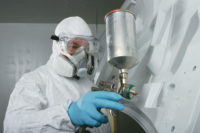
In 2009, the U.S. Department of Labor reported in its Workplace Injury and Illness Summary Report that the “injury and illness incidence rate among private industry employers has declined significantly each year since 2003.”
One factor contributing to the higher rate of workplace safety is an increased use of personal protective equipment (PPE). The increased use of all forms of PPE is the result of compliance with both industry-specific regulations and those outlined by OSHA, as well as strong encouragement from insurance companies. In addition, employers have largely recognized the benefits of protecting their employees who are their most valuable assets. More employees, too, have come to accept the use of PPE as necessary and important to their personal safety and job performance.
PPE products can be found in traditional reusable styles and in disposable or limited-use form. Both reusable and disposable PPE exist in a wide variety of categories with an endless array of features and can provide head-to-toe protection from hazards in any industry. These products provide added benefits beyond safety and protection, allowing users to improve efficiency and performance on the job.
Tech advancements
Many industries have found that disposable or limited-use PPE can be more efficient and functional than reusable equipment, and that the effectiveness and quality of disposable PPE has improved greatly in recent years. Technology advancements and design improvements have made these options more competitive and viable in the marketplace. Some disposable products, including latex and vinyl gloves, hearing and respiratory equipment, are now the industry standard because of their ease of use and hygienic benefits. Disposable and limited-use clothing, protective eyewear and rainwear, while less common, are gaining popularity as practical alternatives to the traditional, reusable products.
Depending on the industry, there are many benefits to disposable PPE options that may make them appropriate, and in some cases, preferable over their reusable counterparts.
Disposable PPE is ideal for industries and jobs where employees are exposed to heavy dirt and grime, such as the construction, manufacturing, sanitation, janitorial and environmental industries. In these cases, cleaning and maintaining reusable PPE products — especially respiratory equipment, gloves and clothing — can be costly, difficult and impractical.
Industries with controlled environments, such as healthcare, food processing and manufacturing, hazardous materials management and infection control, face a unique challenge because the safety equipment used in these applications must be clean and sanitary. To prevent cross-contamination and ensure proper sanitation, employees in these fields may frequently change out their PPE. Disposable options — especially for respiratory protection, gloves and clothing — are a logical solution in these industries.
Disposable PPE can also improve the general hygiene in a workplace, even in industries where hygiene and sanitation are not as critical. More importantly, employees often appreciate that they do not have to share or reuse PPE, leading to an increase in employee satisfaction and in the use of PPE equipment. This helps ensure compliance and increase safety. Because items such as gloves and respiratory equipment aren’t shared, there is also a decrease in illness among employees because germs aren’t passed as directly from worker to worker.
Other industries find that disposable PPE options make sense especially in instances where employees wear the equipment for a limited or short-term use. Protective eyewear, hearing and respiratory equipment fall into this category. The medical, food service and automotive fields often rely on disposable PPE for these uses.
Employers with a temporary workforce often find that disposable PPE offers a cost-effective alternative to reusable PPE. It allows the employer to provide the same high-quality protection and adhere to all industry standards and regulations, without making a deep financial investment in protection per employee. In this case, disposable PPE in all categories — from hearing, respiratory, and gloves to clothing and rainwear — may be preferred. This is particularly true for industries where there are lower safety risks or where lower levels of protection are required.
Choose the best PPE
Disposable PPE does have some limitations and drawbacks. While the quality and comfort of disposable PPE has improved, reusable PPE often fits the user better and provides benefits of breathability and comfort. Disposable PPE products can sometimes be hot and ill fitting. In addition, disposable PPE is not designed to be as long lasting or as resilient as reusable PPE. This is especially true of clothing and respiratory products.
However, the limitations of disposable PPE are often balanced out by the benefits for various industries. Disposable PPE products are designed to keep the cost-per-unit low, and advances in technology and design have closed the gap between the quality and cost of disposable products.
When purchasing any form of safety equipment or PPE, it is always important to consider the environment and conditions of the workplace and the specific job the equipment will be used for to ensure that it is in line with the intended purpose and capabilities of the equipment. For example, disposable PPE meant for dry conditions should not be worn in conditions where moisture or liquid could splash. PPE products should never be used for a purpose beyond their declared and intended use and should always be used in accordance with OSHA and industry-specific regulations. Employers should work directly with their suppliers to determine the best PPE options for their particular project, site, or industry needs.
Disposable PPE products are already widely used in general industries, as well as food service, environmental cleanup, service industries, labs, medical fields, janitorial/ sanitation industry and automotive fields. Their use continues to gain popularity in many other fields and industries. Their functionality and benefits, as well as high quality of protection as compared to cost-per-unit, have made disposable options increasingly common in the workplace. PPE products are playing a prominent role in the effort to improve workplace safety for employees in virtually all fields and industries.
